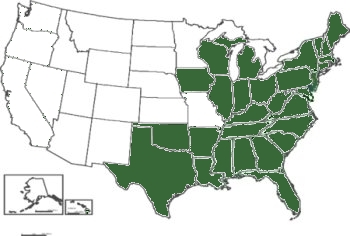Viola x primulifolia L. (pro sp.) [lanceolata x macloskey]��
![Viola x primulifolia L. (pro sp.) [lanceolata x macloskey]¬Ý](images/vipr.jpg) |
Photo courtesy Renee Brecht |
| Botanical name: | Viola x primulifolia L. (pro sp.) [lanceolata x macloskey]�� |
| Common name: | primrose-leaved violet |
| Group: | dicot |
| Family: | Violaceae |
| Growth type: | forb/herb |
| Duration: | perennial |
| Origin: | native |
| Plant height: | 2 - 10" |
| Foliage: | leaves oblong or oval, 1-5" blunt or rounded at the tip, abruptly narrowed at the base |
| Flower: | 1/4 - 1/2" white with purple veins |
| Flowering time: | bloom late April to June; cleistogamous fruit mid August to mid October |
| Habitat: | moist meadows; open woods, stream banks, especially in sandy soil |
| Range in New Jersey: | throughout the Coastal Plain, decreasing in the Pine Barrens; northward through the Piedmont |
| Heritage ranking, if any: | n/a |
| Distribution: |  |
| Misc. | USDA views this plant as a hybrid of lance-leaved violet, Viola lanceolata, and small white violet, Viola macloskeyi or Viola blanda. Other experts regard it as a true species. Most violets are cleistogamous, kleistos, Greek for closed. A cleistogamous flower produces seeds without having produced obvious flowers, as opposed to chasmogamous flowers which open, allowing for pollination. Violets typically produce both types of flowers. |